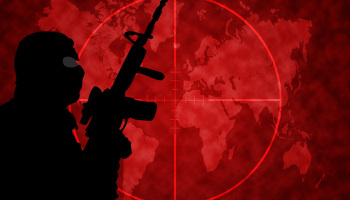The Six ‘Secret’ Tactics of Empire

The 6 ‘secret’ tactics of empire are strategies of change used by governments, usually covertly, to attain political or military ends through means not normally acceptable to the populace as a whole. The strategies are as follows:
1. False Flag Attacks
2. Coercive Engineered Migration
3. Colour Revolutions
4. Humanitarian Intervention
5. Proxy Armies
6. Fake News
The relationship of the state or a political force to the various strategies depends on the political aim. Sometimes there is a direct and openly admitted relationship to the strategy and sometimes it is fervently denied. The outcome of any such strategy is never guaranteed and, indeed, may even have the opposite effect to that intended.
This makes the strategies of change high-risk ventures for the participants as well as those for whom the strategy is hoped to benefit. In some cases these strategies of change seem to be perceived as the only way to change a situation, or at least the most expedient. Their role is to manipulate public opinion on a particular government, state or upcoming political movement to suit the actions, thoughts or desires of another internal or external political force. Like a good magician, the perpetrator of the strategy must make people conscious of the ends but not the means. If the people support a changed environment brought about by strategies of change without realizing or understanding why, then the result can be seen as ‘successful’.
1. False Flag Attacks
 False Flag Attack
False Flag Attack
Triptych – Oil on canvas – (60cm x 180cm / 23.6 in x 70.6 in)
False flag attacks are actions carried out covertly to look like another group, nation or state were responsible. While in theory false flags are secret, some public individuals have openly called for false flag operations to be implemented to serve as a basis for initiating war against another country perceived to be an enemy. The history of false flags, however, is not secret and information about many past successful and proposed attacks is freely available on the internet.
2. Coercive Engineered Migration
 Blue Skies, Blue Seas, Blue Gloves
Blue Skies, Blue Seas, Blue Gloves
Triptych – Oil on canvas – (60cm x 180cm / 23.6 in x 70.6 in)
Coercive engineered migration is a strategy which acts to overwhelm another country’s capacity to cope with a large influx of refugees or migrants. This pressure can affect competing political interests and thereby change the behavior of the target country.
3. Colour Revolutions
 Colour Blind: Orange Revolution – Ukraine, Green Revolution – Iran,
Colour Blind: Orange Revolution – Ukraine, Green Revolution – Iran,
Jeans Revolution – Belarus
Triptych – Oil on canvas – (60cm x 180cm / 23.6 in x 70.6 in)
Colour revolutions are a form of nonviolent resistance utilizing social media, demonstrations and strikes as a protest against governments especially in changing their geopolitical outlook from one radically different in their past. Many non-governmental organizations (NGOs) and students have been involved organizing creative non-violent resistance and usually pick a color or a flower as a symbol of their movement.
4. Fake News
 Green Screen
Green Screen
Triptych – Oil on canvas – (60cm x 180cm / 23.6 in x 70.6 in)
Fake news is a type of news that often uses disinformation to propagate ideas for political advantage through the broadcast media or social media via the internet. It is used to discredit serious media coverage of an event. For example, video footage of riots in one city were used on the news by one network to portray a city in a completely different country in a negative light.
5. Humanitarian Intervention [R2P]
 Humanitarian Warfare
Humanitarian Warfare
Triptych – Oil on canvas – (60cm x 180cm / 23.6 in x 70.6 in)
Humanitarian warfare is an ironic term describing military interventions which give human rights reasons such as protecting a population from genocide, war crimes, ethnic cleansing and crimes against humanity as the basis for their actions.
6. Proxy Armies
 Proxy Army
Proxy Army
Triptych – Oil on canvas – (60cm x 180cm / 23.6 in x 70.6 in)
A proxy army is an army funded and armed by a foreign opposing power who cannot for political or social sensitivities at home fight directly with the country at war.
Caoimhghin Ó Croidheáin is an Irish artist, lecturer and writer. His artwork consists of paintings based on contemporary geopolitical themes as well as Irish history and cityscapes of Dublin. His blog of critical writing based on cinema, art and politics along with research on a database of Realist and Social Realist art from around the world can be viewed country by country at http://gaelart.blogspot.ie/.
All these paintings are from the author.

